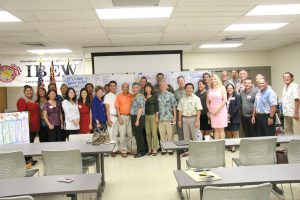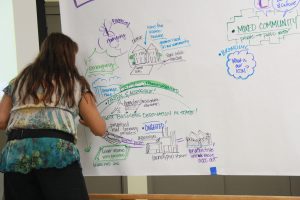Kalihi 21st Century: Public meetings to plan a ‘smart growth’ future
Posted on Oct 25, 2016 in MainSuppose someone asked you to dream — to dream big, to envision your ideal community. What would it include? More

The governor with the Kalihi 21st Century Vision Team he initiated to gather ideas for improving the community.
affordable housing? More parks and better schools? More services close to home?
That’s what Gov. Ige and the state Office of Planning is asking residents to do as part of his Kalihi 21st Century initiative. The committee that includes legislators, community leaders, and non-profit representatives is holding a series of public meetings to imagine a new Kalihi — with rail and without the 100-year-old jail, the O‘ahu Community Correctional Center (OCCC).
The next public meeting is set for 6 p.m. Nov. 15 in Farrington High’s cafeteria. It will be co-hosted by the architecture and planning firm PBR Hawaii & Associates to gather ideas for a “vision concept” for Kalihi. “It’s not a plan, but a vision of what the community wants,” explained state planning director Leo Asuncion. “We hope to have a draft vision by January 2017. Planning for a possible relocation of the jail is moving parallel to that. The visioning process will continue, regardless of what happens with OCCC.”
The jail sits on 16 acres of state-owned land in Kalihi, between two proposed rail stations. Often, he said, the community doesn’t have a chance to weigh in at the beginning of what is usually a complex planning process. “The governor wanted to get more community members involved, thinking about the possibilities at the outset— to hear what they’d like to see and to talk to each other, to make connections within their own Kailhi community,” he said.
And what about the future of rail? “The Kalihi property is also a candidate for transit-oriented development (TOD),” said Asuncion. “Rail is definitely a driver for planning, but the state property is still going to be there, whether rail comes in or not.” In fact, a separate interagency TOD council has been formed to coordinate development along the whole 20-mile rail corridor, with the state of Hawai‘i as the largest landowner of about 2,000 acres within a half-mile radius of the 21 stations.
TOD has been described as a tool for achieving “smart growth,” defined as compact, mixed-use, walkable communities reachable by transportation other than a car — whether it’s a bike, bus or rail. It can be applied to large urban areas such as Kaka‘ako or neighbor island towns such as Līhuʻe, Kaua‘i, where Mayor Bernard Cravalho is promoting smart growth.
“It’s all about what’s right for a community,” said Asuncion. “The key is changing people’s mindsets — weaning folks from their cars.” He said that takes time, which is why the Kalihi 21st Century committee is meeting now. “As a planner, 10 years out is the typical timeline. You don’t just march into the Legislature, get funds and build. Residential development, especially in a TOD area, takes time. If we don’t start talking now, it could be a problem down the line when we want to do something (with a parcel of land), but we have no idea what we want. That’s why we need the community to be part of the vision.”
Read more in our November issue.
